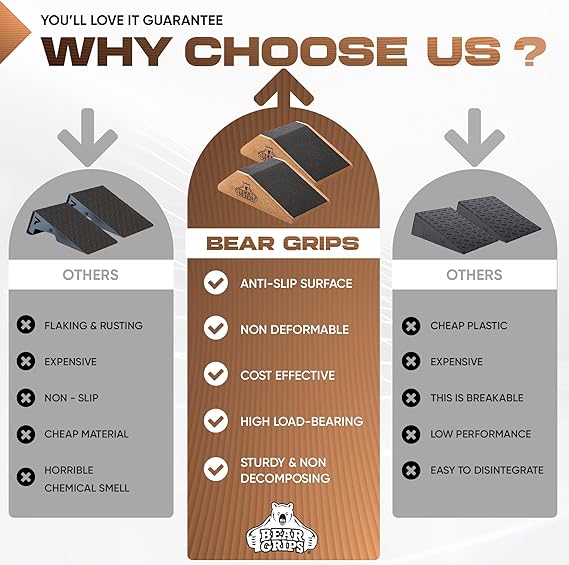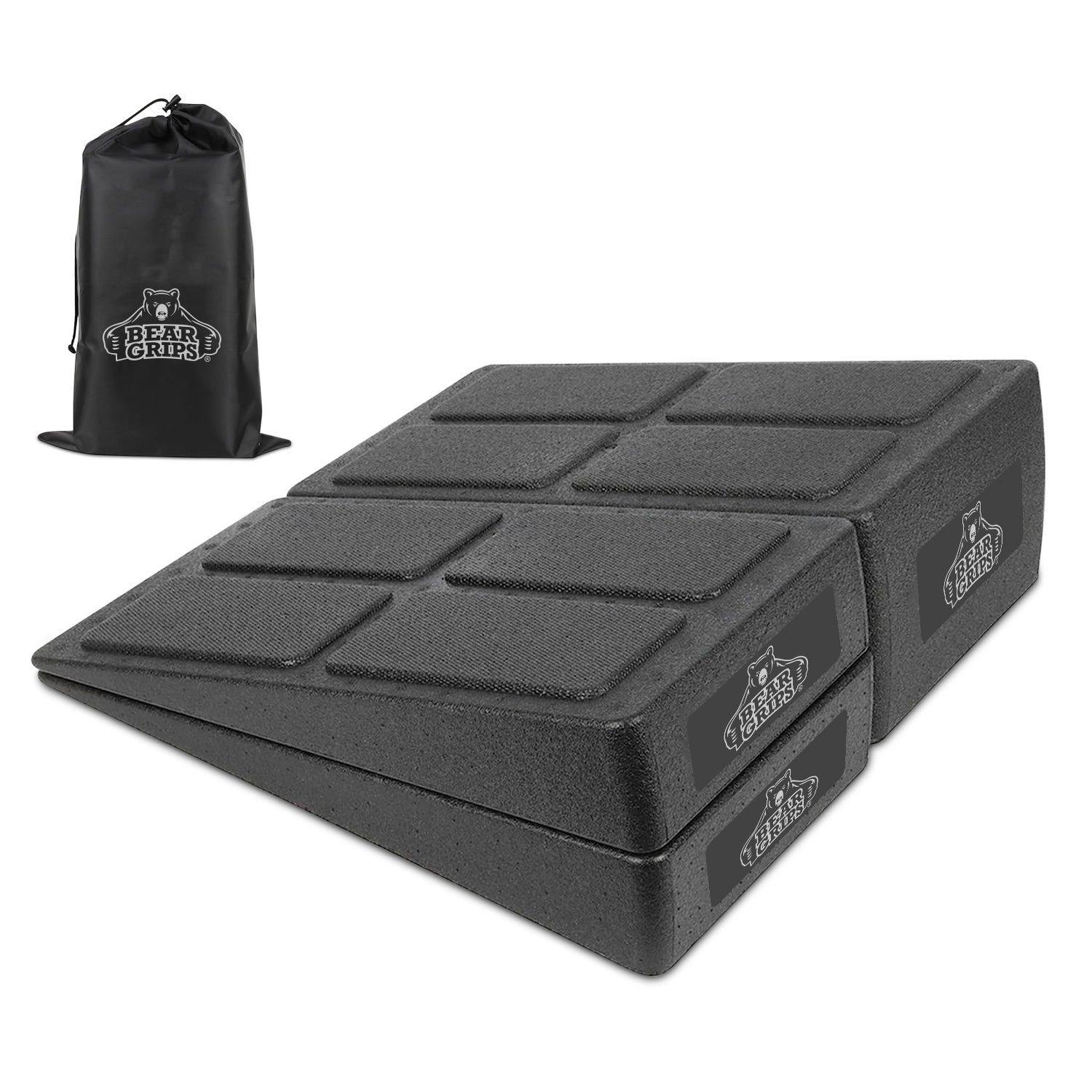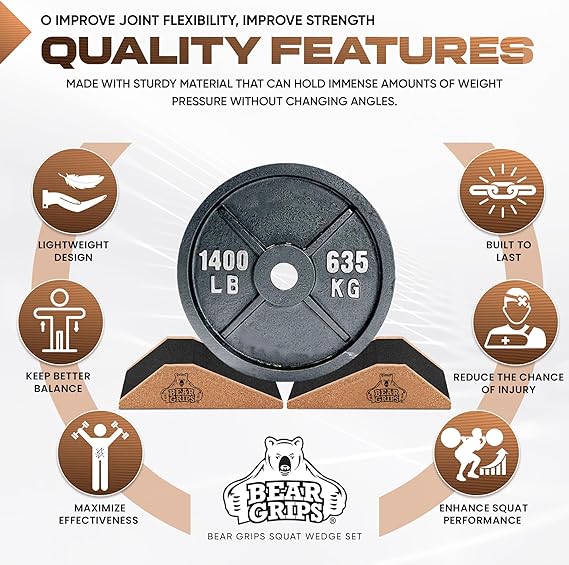
Squat Wedges: Pros, Cons & When to Use Them
Share
Welcome to our comprehensive guide on squat wedges! If you're looking to improve your squat depth, increase lower back safety, or activate your quadriceps muscles more effectively, squat wedges might be the solution for you. Also known as heel-elevated squatting or slant boards, these handy tools have gained popularity among fitness enthusiasts and athletes. However, like any training equipment, squat wedges have their pros and cons, and it's essential to know when and how to use them properly.

In this article, we'll delve into the benefits and drawbacks of squat wedges to help you make informed decisions about incorporating them into your training routine. From improved squat depth to enhanced quads activation, we'll explore how these tools can be advantageous for certain individuals. On the flip side, we'll also discuss the potential strain on the knees and reduced ankle mobility that can occur when using squat wedges.
So, join us as we navigate the world of squat wedges and discover the best ways to utilize these tools for optimal results. Whether you're a bodybuilder, an athlete, or simply someone looking to enhance their squat performance, this guide will provide you with the insights you need to make the most of squat wedges.
Benefits of Squat Wedges: Improved Squat Depth and Quads Activation
Squat wedges present several benefits that can enhance your squat performance and maximize your leg workout. One of the primary advantages of using squat wedges is the improved squat depth they provide. By enhancing your range of motion, squat wedges enable deeper squats, allowing you to engage more muscle fibers and achieve greater muscle activation.
Individuals with limited mobility in areas such as the ankle, hip, and lower back can particularly benefit from squat wedges. These wedges help slacken the posterior chain, which eases tension and allows for a more extended squatting position. As a result, you can target your quads more effectively and achieve better muscle engagement throughout the exercise.

Maintaining proper form and technique is crucial during squats, and squat wedges support this by promoting a neutral lumbar spine extension. This reduces the risk of lower back pain and injury by minimizing excessive stress on the lower back. By providing a stable platform, squat wedges enable you to focus on your leg muscles without compromising your overall posture or spinal alignment.
Furthermore, squat wedges shift the center of gravity, emphasizing quadriceps activation. By altering the angle of the foot, these wedges increase the load placed on the quads, making them work harder during the exercise. This targeted activation can be particularly beneficial for bodybuilders and individuals aiming to build strength and definition in their quadriceps.
Squat wedges have revolutionized the way we approach squatting exercises. By optimizing squat depth and promoting quads activation, these wedges allow lifters to achieve greater muscle engagement and target specific muscle groups more effectively.
By incorporating squat wedges into your training routine, you can unlock the full potential of your squats, improve muscle activation, and enhance your overall leg development.
Drawbacks of Squat Wedges: Knee Strain and Reduced Ankle Mobility
While there are several benefits to using squat wedges, it is important to consider the potential drawbacks as well. Squatting with wedges can increase strain on the knees, particularly for individuals with pre-existing knee issues. The elevated heel position created by the wedges can alter the forces placed on the knees, leading to discomfort or potential injury.
Another drawback of using squat wedges is the potential for reduced ankle mobility. The elevated heel can limit the range of motion in the ankles, making it more difficult to perform deep squats and properly engage the calves and other posterior chain muscles. Reduced ankle mobility can also lead to muscle imbalances and impact overall lower body functionality.
It is crucial to find a balance when using squat wedges to ensure that they do not compromise overall mobility or lead to long-term problems. Combining squat wedge exercises with ankle mobility exercises, such as calf stretches and ankle mobility drills, can help counteract the potential limitations.
Conclusion
In conclusion, squat wedges can be a valuable tool for individuals looking to improve their squat performance and target specific muscle groups, such as the quads. By using squat wedges, individuals can enhance their squat depth, which is particularly beneficial for those with limited mobility in the ankle, hip, and lower back areas. This can help in avoiding pain or discomfort associated with certain orthopedic conditions and reduce the risk of lower back injuries.

However, it is important to use squat wedges mindfully and consider the potential drawbacks. Squatting with wedges can increase strain on the knees, especially for individuals with pre-existing knee issues. Additionally, the use of squat wedges may limit ankle mobility and hinder the activation of the calves and other posterior chain muscles. Therefore, it is crucial to find a balance and ensure that the use of squat wedges does not compromise overall mobility or lead to muscle imbalances.
Squat wedges should be used based on individual needs and goals. They should be supplemented with other exercises to maintain overall mobility and range of motion. By understanding the benefits and drawbacks of squat wedges, individuals can make informed decisions about when and how to incorporate them into their training routine, maximizing their benefits while minimizing the potential drawbacks.
Find best squat wedges for your next workout at Bear Grips!
Shop at Amazon.com Now!
FAQ
What are squat wedges?
Squat wedges, also known as heel-elevated squatting or slant boards, are tools that can be used to improve squat depth and activate the quadriceps muscles more effectively. They are usually wedge-shaped pieces that are placed under the heels during squat exercises.
How can squat wedges improve squat depth?
Squat wedges can improve squat depth by slackening the posterior chain, which allows for greater range of motion in the squat. This is particularly beneficial for individuals with limited mobility in areas such as the ankle, hip, and lower back.
What are the benefits of using squat wedges?
Using squat wedges can increase lower back safety, avoid pain, and help individuals achieve a greater range of motion in the squat while maintaining a neutral position of the spine and avoiding lumbar flexion. Squat wedges also shift the center of gravity, resulting in greater activation of the quadriceps muscles.
Can squat wedges lead to knee strain?
Yes, squatting with wedges can increase strain on the knees, particularly if individuals already have pre-existing knee issues. It is important to use squat wedges mindfully and ensure that they do not compromise overall mobility or lead to muscle imbalances.
Do squat wedges limit ankle mobility?
Yes, using squat wedges can potentially limit ankle mobility and hinder the activation of the calves and other posterior chain muscles. It is important to find a balance and supplement squat wedges with other exercises to maintain overall mobility and range of motion.
When should I use squat wedges?
Squat wedges have a time and place for their use based on the needs or goals of the lifter. They can be beneficial for individuals who lack the required hip or ankle mobility to perform a full-range squat without compromising form and risking injury. By using wedge-based squatting techniques, individuals can achieve a greater range of motion in the squat while maintaining a neutral position of the spine and avoiding lumbar flexion, which can be detrimental to the lower back.


